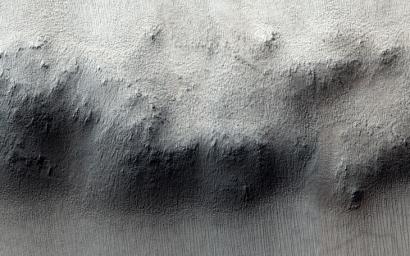
|
Knob in the South Polar Layered Deposits of Mars
- Click the image above for a larger view
- Full-Res JPEG (2880 x 1800) (1.1 MB)
- Full-Res TIFF (2880 x 1800) (15.6 MB)
Caption:
The South Polar Layered Deposits of Mars are a thick stack of layers of ice and dust, deposited over millions of years. The rate of deposition changes over time, and in some times and places the stack is eroded.
Here, a low mesa or ring of hills occurs near the edge of the layered deposits. It is likely that this feature was once an impact crater. The floor of the crater became resistant, and was left behind as the rest of the surface eroded.
Images like this one can show us where the layered deposits are being eroded, and how much ice and dust has been lost. This, in turn, helps us understand the history recorded in the layers .
Background Info:
HiRISE is one of six instruments on NASA's Mars Reconnaissance Orbiter. The University of Arizona, Tucson, operates the orbiter's HiRISE camera, which was built by Ball Aerospace & Technologies Corp., Boulder, Colo. NASA's Jet Propulsion Laboratory, a division of the California Institute of Technology in Pasadena, manages the Mars Reconnaissance Orbiter Project for the NASA Science Mission Directorate, Washington.
Cataloging Keywords:
| Name | Value | Additional Values |
|---|---|---|
| Target | Mars | |
| System | ||
| Target Type | Planet | |
| Mission | Mars Reconnaissance Orbiter (MRO) | |
| Instrument Host | Mars Reconnaissance Orbiter | |
| Host Type | Orbiter | |
| Instrument | High Resolution Imaging Science Experiment (HiRISE) | |
| Detector | ||
| Extra Keywords | Color, Crater, Dust, Impact | |
| Acquisition Date | ||
| Release Date | 2013-07-10 | |
| Date in Caption | ||
| Image Credit | NASA/JPL-Caltech/Univ. of Arizona | |
| Source | photojournal.jpl.nasa.gov/catalog/PIA17722 | |
| Identifier | PIA17722 | |
